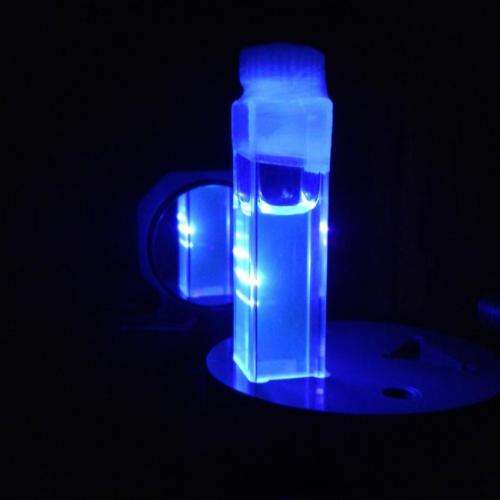Novel inorganic material emitting laser light in solution discovered

A team of scientists from the Spanish National Research Council and the Academy of Sciences of the Czech Republic has discovered a new type of laser material based on an inorganic molecule—a complex of boron and hydrogen and no carbon atoms—that emits laser light in solution.
The work, published in Nature Communications, demonstrates that the new material presents efficient and degradation-resistant laser emission in the blue, a spectral region of interest in applications such as spectroscopy or materials processing, among others.
The first laser was developed in 1960 and 55 years later, there is still a search for new materials that emit efficient, tuneable and stable blue laser light, that are, in addition, cost-effective, and easily produced and processed. "Nowadays there exists a diverse range of commercial materials that are close to fulfilling those requirements, but they present some practical inconveniences. In our study we present a solution that seeks to contribute to overcome these limitations," clarifies Inmaculada García-Moreno, CSIC researcher at the Institute of Physical Chemistry Rocasolano.
New uses for a known compound
Despite not being a novel material, this is the first time that the boron hydrides, or boranes, have been used to obtain laser light. "We have concentrated our work on solutions of anti-B18H22, a cluster-like molecule with architecture resembling that of a split soccer ball," says Michael Londesborough, borane specialist from the Institute of Inorganic Chemistry. Of all the laser materials known so far, boranes are, in terms of structure and properties, most similar to organic dyes, which emit laser light in an efficient and tuneable manner (very high energy with controllable colour), but that are easily degraded, necessitating the frequent renewal of the laser medium.
The new borane laser material shows a resistance against degradation that is superior or similar to many of the commercially available state-of-the-art blue laser dyes. This high resistance against degradation means that the number of times the liquid medium has to be replaced is reduced, helping to solve issues with costs, occupational hazards and environmental impact due to handling of solvents, which are toxic and flammable.
The team of researchers is planning to synthesize new boranes emitting at other wavelengths (colours), as this would open the doors to, for example, their possible application in dermatology (Tattoo, scar or acne removal, as well as treatments of vascular lesions, to name but a few potential applications). "There is still plenty of work to be carried out before these compounds can reach the commercial shelves, but the scientific relevance of this discovery represents a milestone in the history of lasers, since there are not many occasions in which a new family of laser materials is unveiled," concludes Luis Cerdán, a CSIC researcher at the Institute of Physical Chemistry Rocasolano. Dr. Michael Londesborough agrees, "We are highly excited by this discovery. The boranes, with their unique molecular structures and high photostabilities, present a new and previously untapped resource for laser technology."
Journal information: Nature Communications
Provided by Spanish National Research Council



















